Paper presented at 60 th International Homeopathic Congress organized by LIGA at Berlin, Germany from 4 th May 2005 to 7 th May 2005.
Cost Effectiveness and Efficacy of Homeopathy in Primary Health Care Units of Government of Delhi- A study*.
Dr. Raj Kumar Manchanda 1 and Dr. Mukul Kulashreshtha 2
| 1. | Deputy Director (Homeopathy), Directorate of ISM and Homeopathy, Nehru Homeopathic Medical College and Hospital, B-Block, Defence Colony, New Delhi, India, Mobile No- 9811014493, ddh[at]touchtelindia[dot]net – rkmanchanda18[at]yahoo[dot]com |
| 2 | Chief Medical Officer (Allopathy), Directorate of Health Services, Government of Delhi, F-7, Karkadooma, Delhi |
Background Comparative studies and surveys have contributed to the opening of 12 new homeopathic clinics in Delhi under the cafeteria approach. This approach has now been accepted as a policy of the Government for the expansion of homeopathy.
| Aim: | To assess the cost effectiveness and efficacy of the homoeopathic clinics under the cafeteria approach. |
| Methods. | Two studies were undertaken. |
| Study 1. | The data of one year (199-2000) pertaining to homeopathic clinics in respect of patient turnover, morbidity profile and expenditure incurred on salaries and medicines, were compared to the allopathic clinics functional at the same centre. |
| Study 2. | 57 homoeopathic clinics were surveyed during February – March 2003. The staff members and 840 patients attending these clinics were interviewed using structured proforma. Several aspects including economic, cultural, social, patient satisfaction and administrative factors etc were studied. |
Results :
Study1.
1.25 million Patients visited the homeopathic clinics and their morbidity profile included respiratory diseases gastrointestinal diseases skin diseases female diseases viral diseases and injuries and other miscellaneous diseases. The average annual patient turnover in an allopathic clinic was 27508 patients and 24943 patients in a homeopathic clinic respectively.. The expenditure incurred per patient per visit in allopathic clinic was Rupee 76.90 and Rupee 15.43 in Homeopathic clinic respectively.
Study2.
The survey revealed that majority of patients attending these clinics were fully satisfied and the staff at these clinics were very cordial, cooperative and confident. There were instances of mutual referral of patients from allopathic clinic to homeopathic clinic and vice-versa.
Conclusion.
Both the studies established beyond doubt that homeopathy is quite popular, very cost effective and can be widely used at primary health care level for the common day to day diseases.
Key words:
cafeteria approach, primary health centre, cost effectiveness, efficacy of homoeopathy.
Introduction
Homeopathy is one of the recognized systems of medicine in India and widely practised. There are 0.3 million qualified homeopaths, 180 colleges, 7500 government clinics, 307 hospitals and 24 State Boards for the registration of qualified practitioners of Homeopathy. Delhi, the capital of India is an old city and has a total population of 13.7 million and about 35% of the population belongs to the poor strata residing in slums. The Government of India as well as Govt. of Delhi is committed towards the development of Homeopathy along with the other traditional systems of medicine along with allopathy. Government of Delhi has adopted a policy of cafeteria approach at primary health care level and 28 homeopathic clinics were established in allopathic health centers in 1978. The patients have the option of availing the treatment of their own choice in these centers. Over the years, these clinics have increased to 69 and the number of patients attending the homeopathic clinics has steadily increased. A need was felt to assess the costs and efficacy of homeopathic clinics before the existing facilities could further be expanded. Thus comparative studies of the expenditure patterns, morbidity profiles of patients of both homeopathic and allopathic clinics were undertaken and a survey was also conducted to assess the patient satisfaction levels.
Study 1- To assess the cost effectiveness of homeopathy
Aims and Objectives :
| 1. | To compare the expenditure incurred by government towards running of allopathic and homeopathic clinics. |
| 2. | To assess the cost effectiveness of homoeopathy. To analyze the morbidity profile of patients coming to homeopathic clinics in comparison to allopathic clinics |
Methods :
The revenue expenditure incurred on salaries and medicines of both types of clinics were compared. The information was obtained from government records. The capital expenditure on the maintenance of these clinics was excluded as the clinics functioned in the same buildings. The morbidity data was compiled using the disease classification system ICD- 9 of World Health Organization. The reports were tabulated and frequency of diseases of both types of clinics was analyzed to understand the load of different diseases on the homeopathic health care system. During the year 1999-2000, 139 allopathic clinics and 48 homeopathic clinics existed. Review meetings were conducted with the doctors to understand and verify the data being considered by them before finalizing the report for submission.
Results & Discussion
Table No- 1: Total Number of Patients
| Clinics | Number of Clinics | Number of Patients Attended | Annual Turnover Of Patients Per Clinic |
| Allopathic | 139 | 3,823,689 | 27,508 |
| Homeopathic | 48 | 1,197,249 | 24,943 |
The patient’s attendance patterns revealed that homeopathic clinics were as popular as allopathic clinics at the primary health care level.
Table No. - 2 -Total Revenue Expenditure
| Clinics | Total Expenditure (in INR) | Total No.of Patients Attended | Average Expenditure Per Patient Visit(in INR) |
| Allopathic | 294,188,000 | 3,823,689 | 76.9 1.32 (€/Euro) |
| Homeopathic | 18,472,000 | 1,197,249 | 15.43 0.26(€/Euro) |
Table 3. Expenditure per Clinic
| Expenditure Heads | Expenditure (in INR) | Average Expenditure per clinic INR) |
|---|---|---|
| Allopathic Clinics (n= 139) | ||
| Salaries | 259,988,000 | 1,870,417 32,249 (€/Euro) |
| Medicines | 34,200,000 | 24,6043 4,242 (€/Euro) |
| Total | 294,188,000 | 2,116,460 36,491(€/Euro) |
| Homeopathic Clinic (n= 48) | ||
| Salaries | 16,272,000 | 339,000 5,844(€/Euro) |
| Medicines | 2,200,000 | 45,833 790(€/Euro) |
| Total | 18,472,000 | 384,833 6,634(€/Euro) |
Table 4- Expenditure per Patient Visit
| Expenditure Heads | Expenditure(in INR) | Average Expenditure Per Patient INR) |
|---|---|---|
| Patients at Allopathic Clinics (n= 3,823,689) | ||
| Salaries | 259,988,000 | 67.99 1.17 (€/Euro) |
| Medicines | 34,200,000 | 8.94 0.15(€/Euro) |
| Total | 294,188,000 | 76.93 1.32 (€/Euro) |
| Patients at Homeopathic Clinics (n= 1,197,249) | ||
| Salaries | 16,272,000 | 13.59 0.23- (€/Euro) |
| Medicines | 2,200,000 | 1.84 0.031- (€/Euro) |
| Total | 18,472,000 | 15.43 0.261- €/Euro) |
The expenditure in homeopathic clinics was one-fifth of the expenditure in allopathic clinics both in terms of salary as well as medicines. The reason for greater expenditure on salary indicates that the allopathic clinics require more supportive staff than homeopathic clinics.
Table 5- Morbidity Profile of Patients
| S. No. | ICD 9 code | Group of Diseases | Allopathic (In %) | Homeopathic (In %) |
|---|---|---|---|---|
| 1. | 001-139 | Infections | 20.5 | 21.2 |
| 2. | 140-239 | Tumors, malignant/benign | 0.1 | 0.1 |
| 3. | 240-359 | Endocrine, deficiency, blood, mental & nervous system diseases | 10.4 | 4.3 |
| 4. | 360-389 | Diseases of eyes and ears | 6.4 | 4.3 |
| 5. | 390-459 | Diseases of Heart & Circulation | 1.8 | 3.7 |
| 6. | 460-519 | Diseases of Respiratory tract | 27.4 | 22.1 |
| 7. | 520-579 | Diseases of GIT | 3.5 | 8.3 |
| 8. | 580-599 | Diseases of Urinary system | 1.4 | 2.0 |
| 9. | 600-679 | Diseases of genital tract, Pregnancy and child birth | 3.5 | 7.0 |
| 10. | 680-709 | Diseases of skin & subcutaneous tissue | 6.1 | 10.8 |
| 11. | 710-779 | Diseases of Connective tissue, joints, congenital anomalies etc | 2.7 | 0.8 |
| 12. | 780-799 | Ill defined diseases | 9.2 | 9.3 |
| 13. | 800-909 + | Fractures, injuries, poisoning others etc | 7.1 | 5.9 |
Figure 1. Graphical Presentation of the Morbidity Profile of Patients of Both Clinics
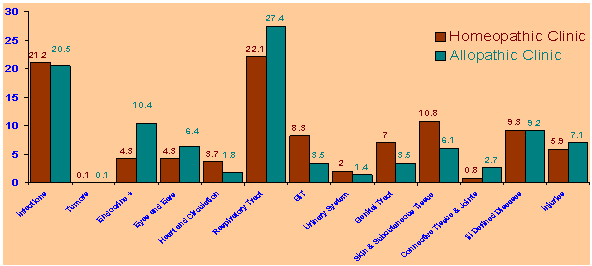
The morbidity profile of both types of clinics reveals that diseases of respiratory tract, infections, GIT diseases and skin diseases are the most common diseases at PHC level.
Table 6 – Anamnesis of Disease Sub Groups
| S.No | Allopathic Clinic | Homeopathic Clinic |
|---|---|---|
| 1 | Infections (001-009) | |
| Amoebiasis Tuberculosis Malaria STD’s Worm infestations |
Diarrhoea Viral fevers Worm infestations |
|
| 2. | Tumors(140- 239) | |
| Malignant | Benign | |
| 3. | Endocrine& Metabolic diseases (240-359) | |
| Diabetes Mellitus Thyroid disorders Anaemias Nutritional deficiencies |
Nutritional deficiencies Anaemias |
|
| 4. | Eyes and Ears | |
| Cataract Blindness and low vision Otitis media and mastoiditis Glaucoma |
Cataract Otitis media and mastoiditis |
|
| 5. | Heart and Circulation | |
| Hypertensive heart diseases Rheumatic fever and rheumatic heart disease Ischaemic Heart Diseases |
Hypertensive heart diseases Ischaemic Heart Diseases Hemorrhoids |
|
| 6. | Respiratory Diseases (460-519) | |
| Bronchitis, Chronic and Unspecified emphysema and Asthma Acute Bronchitis and bronochiolitis Pneumonia |
Chronic diseases of tonsils and adenoids Influenza Bronchitis, Chronic and Unspecified emphysema and Asthma |
|
| 7. | GIT Diseases (520-579) | |
| Ulcer of stomach and duodenum Chronic liver diseases and cirrhosis Cholelithiasis and cholecystitis Appendicitis Hernia of abdominal cavity |
Chronic dyspepsia Chronic Liver diseases |
|
| 8. | Urinary System (580-599) | |
| Infections of Kidneys Nephritis, Nephrotic Syndrome and Nephrosis Infections of Kidney |
Urinary Calculus | |
| 9. | Genital Tract (600-679) | |
| Menstrual Disorders Salpingitis and oophoritis Infertility Females |
Menstrual Disorders Infertility Females Uterine Fibroid Menopausal problem |
|
| 10. | Skin and subcutaneous tissue (680- 709) | |
| Scabies Fungal Infections Psoriasis Pyoderma |
Wart Molluscum Contagiosum Alopecia areata Urticaria |
|
| 11. | Connective tissue and joints (710-779) | |
| Rheumatoid Arthritis Ankylosing spondylitis Osteomyelitis |
Rheumatoid arthritis Osteoarthritis |
|
| 12. | Ill defined diseases (780-799) | |
| 13. | Injuries (800 -909 +) | |
| Open wounds and injury to blood vessels Dislocations, sprains and strains Burns Fractures |
Dislocations, sprains and strains Injuries Burns |
|
The data revealed that under different disease sub-groups, the patterns were not similar in both the types of clinics. However at times, these clinics complemented each other. Allopathic had been found to be preferred by patients with acute diseases and homeopathy by patients with sub-acute and chronic diseases. The above preference indicates the strengths and limitations of both the systems as per perception of the public.
Study –II- Evaluation Study to assess the Effectiveness of Homeopathic Clinics running adjacent to Allopathic Clinics at Primary Health Care Level. This study was conducted in collaboration with an independent agency, Planning and Evaluation Department, Govt. of Delhi to assess the effectiveness of homeopathic clinics functioning at the primary health care level for deciding upon further expansion of homeopathy under the cafeteria approach at Primary Health Care Level.
Objectives : To assess the patient satisfaction levels relating to the services provided by the homeopathic clinics. To assess the perceptions of Allopathic doctors towards homeopathic clinic
Methods
The field survey of homeopathic clinics was conducted from 20.2.2003 to 25.03.2003. The study team interviewed 10 to 15 patients from each clinic and the staff working in homeopathic as well as allopathic clinics during the field visit. Separate structured questionnaires were used for both types of interviews. 57 homeopathic clinics and 840 patients were covered during the survey.
Results/Discussion
Figure no -2 – Utilization of Homeopathic Clinics
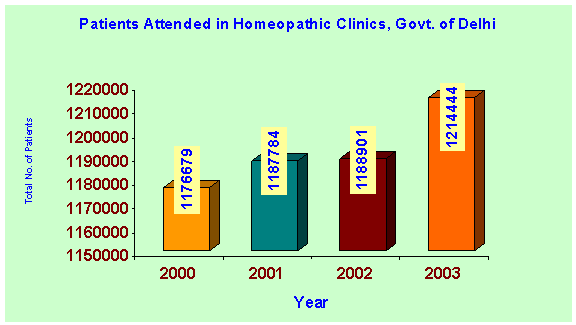
The number of patients in Homeopathic dispensaries is steadily increasing and indicates the growing popularity of the system.
Table No- 6- Perceptions of 53 Doctors of Allopathic Clinics
| Yes | No | |
| Whether it is beneficial to run Homeopathic clinic from the same premises | 46 (87%) |
7 (13%) |
| Whether the running of Homeopathic clinic creates any problem | 12 (22%) |
41 (78%) |
| Whether the doctors of Allopathic clinic refer the patients to Homeopathic clinic | 46 (87%) |
7 (13%) |
Majority of doctors of allopathic clinics felt that homeopathic clinics existing within the allopathic clinics are beneficial for the patients and they do not face any problems in running in this regard and also refer the patients to homeopathic clinics for treatment.
Figure- 3 - Awareness to Homeopathic Clinics amongst beneficiaries (n=840)
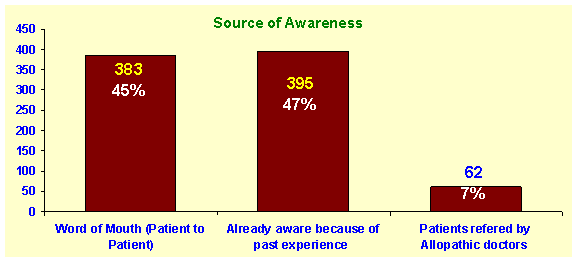
The awareness among 383(45%) patients was through word of mouth (patient to patient contact). This indicates the acceptability of Homeopathy among general population.
Figure-4 – Economic Status of Patients
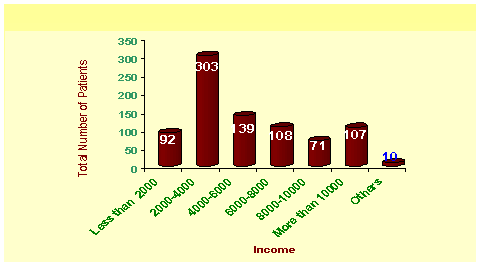
The economic status of patients revealed that most of the patients were from the lower and middle income group. It will be pertinent to add that rich population generally consults private homeopathic consultants.
Figure-5 – Occupational Status of Patients
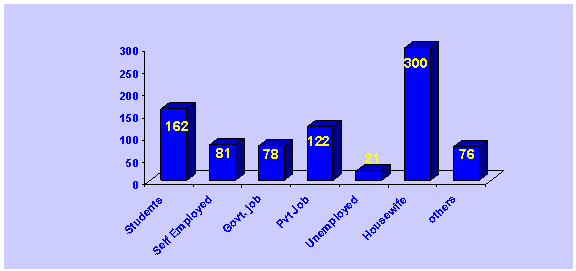
The patients attending homeopathic clinics were involved in various occupations from all strata of society. The timings of the clinics were suitable and popular in housewives.
Figure-6 – Patient Satisfaction Levels (n= 750 patients)

The patient satisfaction level was very high and gratifying.
Figure 7- Preference of Patients for the Homeopathic clinics
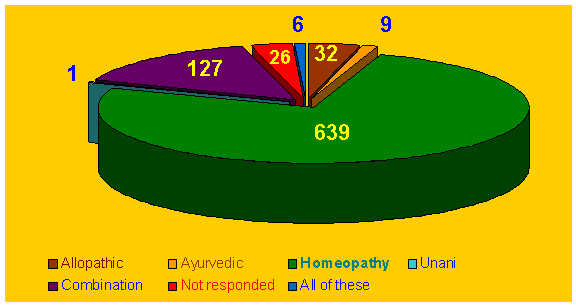
639 patients (85.2%) felt that homeopathic system of medicine is better than other systems of medicine. The study showed that patients also visit the allopathic clinics and other clinics as per their requirements and preferred to use different systems of medicine as per their experience and advice of physicians.
Figure- 8 -Reasons for Preference for Homeopathy

Most of the patients were of the opinion that homeopathy is safe, easy to take, cost effective and had adequate faith in Homeopathy in accordance with their past experiences.
Conclusion :
Both the studies have established that homeopathy is a popular, affordable and efficacious system of medicine at primary health care level. Homeopathy has the potential to minimize the health care expenditure substantially if promoted at primary health care level through the cafeteria approach, as is being adopted by Govt. of Delhi.
Recommendations
Homeopathic Clinics may be promoted at primary health care level to minimize the costs of health care in developing countries. The Indian government’s policy of ensuring adequate growth of recognized systems of medicines has contributed significantly towards the development of homeopathy in India. The cafeteria approach can be adopted in other countries also for minimizing costs and for promoting patient satisfaction at Primary Health Care Level. Global Potential India has the largest homeopathic infrastructure in terms of manpower, institutions and drug manufacturing industry, which can be effectively utilized globally. India is also rich in clinical and research experiences. Homeopathy in India enjoys political commitment, government’s patronage and adequate statutory controls on education, practitioners and drug control, which can be adopted as models for the global growth of homeopathy.
References :
Evaluation Study Report, May 2003, Planning Department, (Evaluation Unit), Govt. of NCT of Delhi, 2 nd Floor, ISBT Building, Kashmere Gate, Delhi
Annual Reports -1999-2000, Directorate of Health Services, Govt. of NCT of Delhi, F-7, Karkadooma, Delhi for the year 1999-2000, 2000-01.
Monthly and Morbidity Reports of Homeopathic Clinics, Govt. of Delhi.
International Classification of Diseases, World Health Organization ICD-9.
About the Authors :
Dr. Raj Kumar Manchanda 1

Presently appointed as Deputy Director (Homeopathy) in Directorate of Indian System of Medicines and Homeopathy, Government of Delhi. He is an enthusiastic clinician and has conducted several researches in scientific manner. He has published many research papers in various national and international journals. He is a member of Central Council of Homeopathy and also teaches homeopathic treatment of skin diseases at Nehru Homeopathic Medical College and Dr. B.R. Sur Homeopathic Medical College, New Delhi.
Dr. Mukul Kulashreshtha 2

Has specialized in community Health Administration. He has worked as clinician at government dispensaries and has extensive administrative experience in management of hospital, held various administrative posts in state health directorate and worked in public health programmes like AIDS Control.
Acknowledgement :
The authors are thankful to the officers and officials of Planning Department, Evaluation Unit, Directorate of Health Services, Homeopathic clinics and Directorate of ISM and Homeopathy, Govt. of Delhi for their cooperation in the studies and survey.


 Department of Homeopathy
Department of Homeopathy


